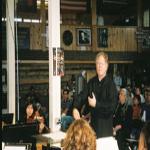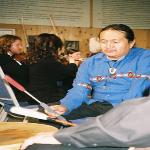26 October 2010

Photo: VOA - J. Kent
The Porcupine Singers perform as part of The Lakota Music Project. Ronnie Theisz (left), professor emeritus of American Indian Studies at Black Hills State University, has been with the group since 1972.
It's not unusual to find musicians from different genres - or from different cultures - collaborating. Opera star Luciano Pavarotti belted out the blues with Eric Clapton and South Africa's Ladysmith Black Mambazo recorded an album with folk legend Paul Simon.
Another more recent musical mash-up has a traditional Native American drum group performing with a classical symphony orchestra.
Musical mash-up
The Porcupine Singers, a traditional Lakota drum group, performs throughout South Dakota. So does the South Dakota Symphony Orchestra. But they never performed together - until last year.
"Any conductor coming into a new music directorship with an orchestra is gonna spend time taking stock of the community and how the orchestra serves the community," says Delta David Gier, who took the helm of the South Dakota Symphony Orchestra in 2004. His goal was to bring classical music to what he saw as traditionally underserved areas of the state. His immediate thought was the African-American community.

VOA - J. Kent
Delta David Gier leads the South Dakota Symphony Orchestra and the Porcupine Singers in a performance by the The Lakota Music Project."I met this woman who was in charge of the Martin Luther King Day celebrations in Sioux Falls and we struck up a conversation. I said, 'You know, a lot of orchestras are involved with Martin Luther King Day. They have concerts and invite African-American choirs and artists and so on.' She listened and when I finished talking she said, 'That's really nice if you want to pursue that. But I've got to tell you, I'm a black woman and I don't have a problem in South Dakota. If you want to talk about racial prejudice here, you've got to talk about Native Americans.'"
Reaching out
Gier followed her advice and set up a meeting with some of the state's Native American leaders, including Barry Lebeau, a Lakota who works with Native American artists across the state.
Lebeau told him that ensembles from the South Dakota Symphony Orchestra had visited various reservations over the years for educational purposes.
"But he wanted to do something more that involved the greater symphony and American Indian music," says Lebeau. "I was intrigued."

VOA - J. Kent
Tim Black Bear and the Porcupine Singers perform with the South Dakota Symphony Orchestra.LeBeau put Gier in touch with Ronnie Theisz, professor emeritus of American Indian Studies at Black Hills State University. Although he's not a Native American, Theisz has sung with the Porcupine Singers since 1972. He's now their oldest and most experienced member.
Playing with tradition
The group is known across the country for keeping the traditional songs of the Lakota alive. They've sung at the Kennedy Center and in the film "Dances With Wolves". But collaborating with the South Dakota Symphony Orchestra raised a concern
"For traditional singers, the compelling value is always to preserve the tradition, not to experiment too much, not to change things to make it like Anglo music," Theisz says.??
But since the Lakota Music Project, as it was called, would combine aspects of classical and traditional Lakota music, Theisz and the Porcupine Singers felt it could work. And - from its first performance in May, 2009, it did.
The first part of a Lakota Music Project concert offers individual selections by both groups, musically reflecting the human conditions of love, war, death and joy. During the second half of the program, the groups combine their sounds in a composition written especially for the project.
Unique collaboration
Both Native and non-Native musicians enjoyed the collaboration. Violinist Magdalena Modzelewska, who grew up in Poland, has played with the orchestra since 1998. She sees this project as an incredible musical and cultural journey.
"You feel the, the greatness of the moment, the importance of it," she says. "And it's wonderful, It really is wonderful."
Porcupine Singer Emanuel Black Bear agrees.
"We sing a lot of old songs, and so does the orchestra. A lot of thought's gone into these songs and what we're doing and it's for our music. You know, no matter what race you are, it's the music."
And the music will continue. Another piece has been commissioned for future performances so the Lakota Music Project can continue to share and expand its unique sound.